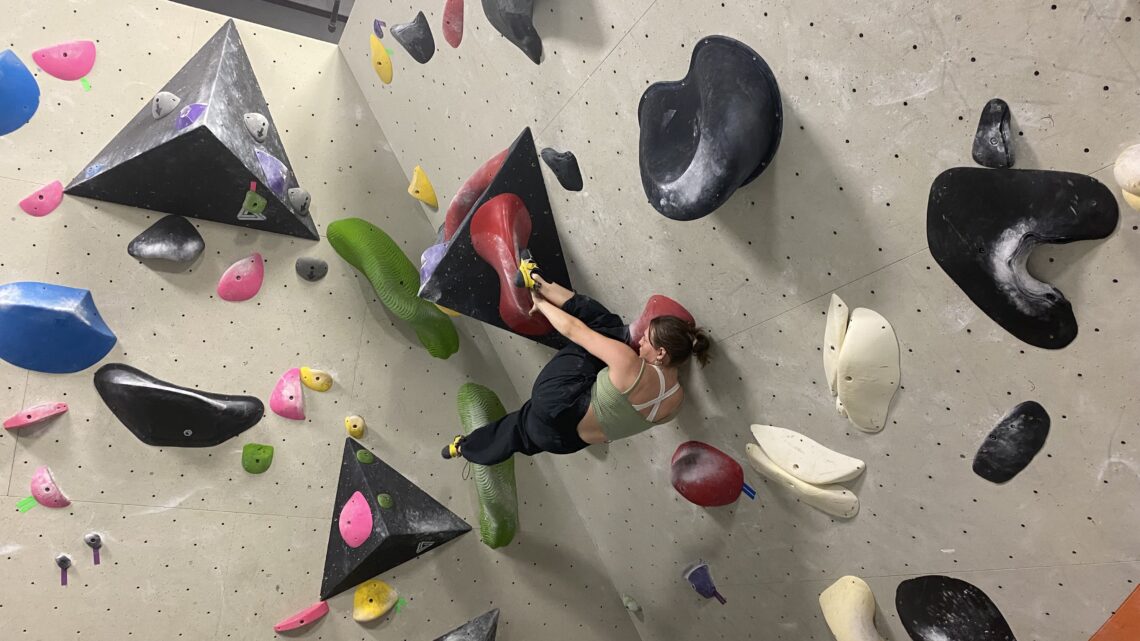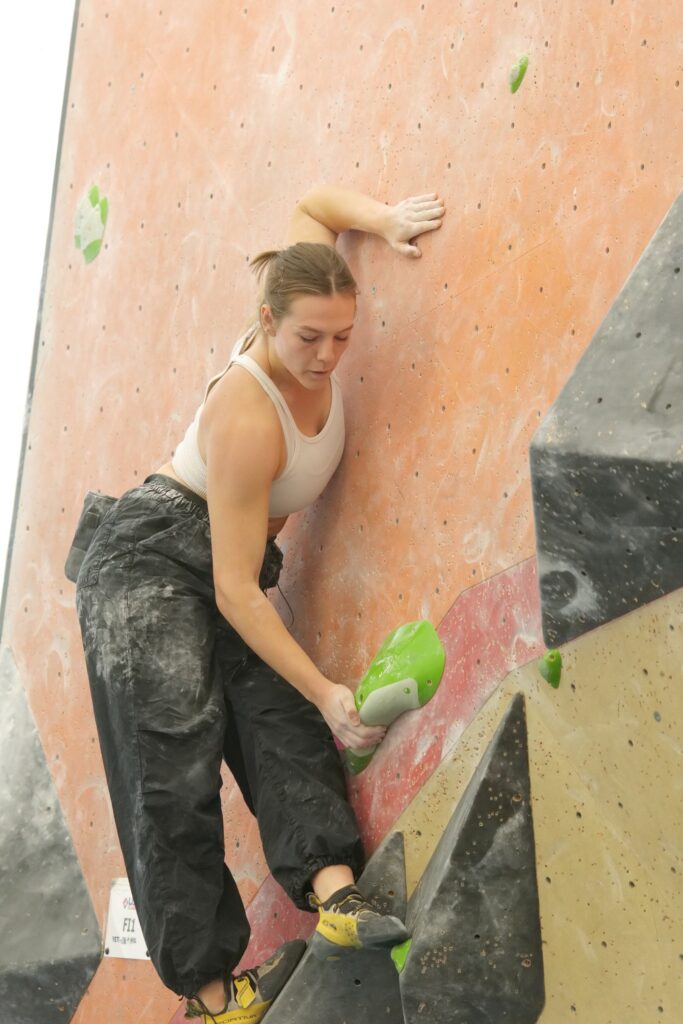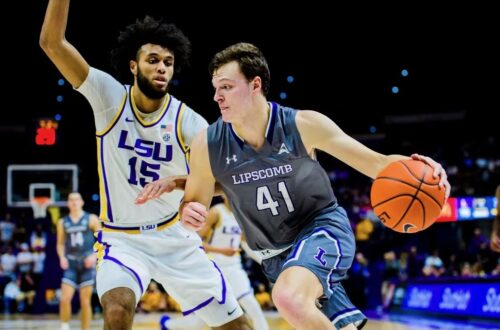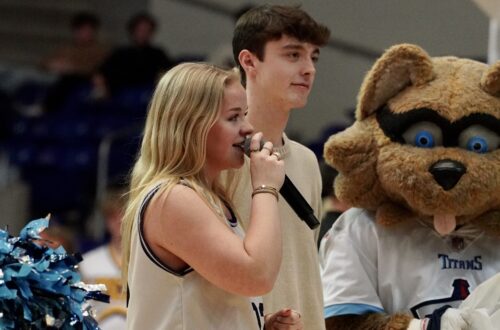
From the rock climbing club to a spot in Nationals
When most people think of rock climbing, not many imagine a sport. And not many imagine that sport to be as organized and tiered as other college and professional level sports. But it is, and Lipscomb junior Kalissa Finn is not only excelling in the sport, but climbing through those tiers.
Finn, who started climbing seriously when she was 18, recently reached another level in the climbing world. Placing fifth in the Regional competition in Kennesaw, Georgia, Finn earned a spot to compete in Nationals.
A fashion major at Lipscomb University, Finn spends her days in the fashion labs piecing together unique designs, and her nights in a very unique kind of gym. Called The Crag, Finn spends hours there throughout the week.
“[I go] climbing three times a week, and I’m training outside of those climbing times four to five times a week,” Finn said. “I did the math, [and] it’s almost a thousand minutes a week.” That’s a lot of time for anyone to devote to something, especially when there’s also the balance of hours designing and sewing in the fashion lab, doing other homework, and maintaining a job and a social life. But Finn spends almost seventeen hours a week training and climbing, because the sport is a lot more than just playing around on rocks.
“Rock climbing has a competitive factor,” Finn said. “It’s usually indoor, [and] there’s three different disciplines in it.” There’s Lead Climbing, which is perhaps what most people think of when they envision rock climbing; speed climbing, where the goal is in the name; and bouldering. “Bouldering is my discipline. You’re not roped in [and] it gets only a few meters off the ground maximum because it’s slightly more dangerous,” Finn explained. “Boulder routes tend to be slightly more powerful, shorter. You have to think about it a little bit more. Not that you don’t for others, but like, because it’s more compacted into a small area it tends to be more challenging.” She laughed. “You kind of get addicted to it.”

Just like with any other sport, rock climbing has its’ own challenges, and Finn has had to overcome some unique ones. “I’ve kind of been on this journey by myself,” Finn admitted. “I don’t have a coach. I don’t have somebody to tell me this is what to expect… This is my first time so I don’t know what anything will look like.” Another problem facing Finn is that she is not recognized by Lipscomb as an “actual” athlete.
“It’s not just some piddly side-hobby – it’s a full-time thing,” Finn said. “But I think a lot of my teachers right now just think it’s a hobby or something. They don’t really understand how much work I put into this and how much work it entails to get to the point that I’ve gotten to.”
Finn, who not only devotes hours to training and climbing, drives across the country to compete, which has nearly caused problems in the past. Many teachers who will grant athletes absences for their away games will not be as flexible with Finn’s schedule. “Right now, because I’m a highly organized person, I can juggle it and I can incorporate [everything] into my schedule without having really detrimental effects, but it would be nice to be able to have that kind of recognition. [Especially] next year, when I’ll be juggling 18 hour semesters too. It’s already a lot with 16 hours.”
Nationals may help with that recognition, however. “I’m hoping that [if I win], Lipscomb will recognize me as an athlete.” Currently competing in the intermediate women’s tier, Finn also hopes to move up a level. “Hopefully it’ll open up opportunities for me to move up into advanced women’s competing, but also maybe international. It also definitely opens the opportunity for scholarships, outside of Lipscomb. But the biggest thing I’m hoping [for] is [recognition from] Lipscomb.”

The competition at Nationals also presents its’ own challenges. Not only will the climbs be harder, but the competition will be formatted in what’s called a Rotational Red-point Format. Most competitions are in what’s known as the Traditional Red-point Format. In the Traditional format, climbers have three hours to get as close to the finish as possible on six different routes, with ten attempts allowed per route. The Rotational format is much harder. Finn explained the format – which happens to be one she’s never competed in before.
“I’ll go in – I haven’t really gotten to go look around or scout the boulders out – [they’ll] be new for me. I’m going to go and look at the route and I get four minutes on the clock to try to figure out this boulder. I have to keep going at it without rest for four minutes to try to get to either the top or the zones on that boulder. And once that timer goes off, [I’ll] get moved. I get four minutes off [to rest] and then [I’ll] get moved to another boulder. It’s very intensive… and I’m not sure [if you get to come back to a route]. I really hope that I get to come back around to it.”
“I’ve been starting to train in this way,” Finn added. “I’ll go and I’ll set a timer, I’ll look at a route for the first time. Usually right now, unless it’s fairly within my range, I’ll get it in the second four minute segment, but not the first. So, I’m just hoping to be able to do a challenging boulder within the four minutes. Not one that I feel like was a gimme.”

“I just like climbing rocks,” Finn closed the interview with a smile.
Not only does Finn love what she does, she’s good at it too. This is her first year officially competing, and she’s made it through multiple rounds of qualifying competitions, Regionals and is on her way to Nationals. Finn will compete at Nationals in Gilbert, Arizona, from May 24-26. She plans to compete in a way that will make herself proud, her friends in the New Heights Climbing Club, and hopefully her school.
All photos courtesy of Kalissa Finn.






